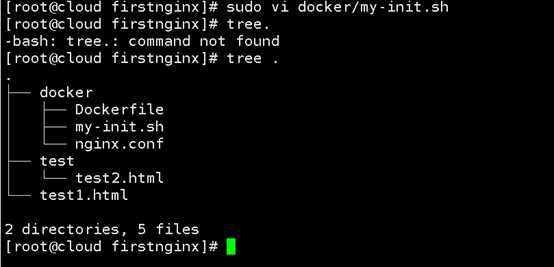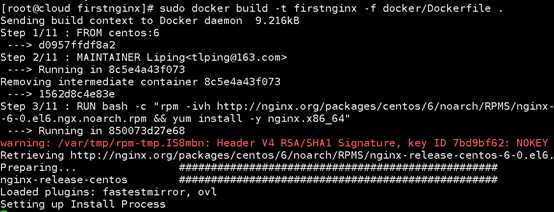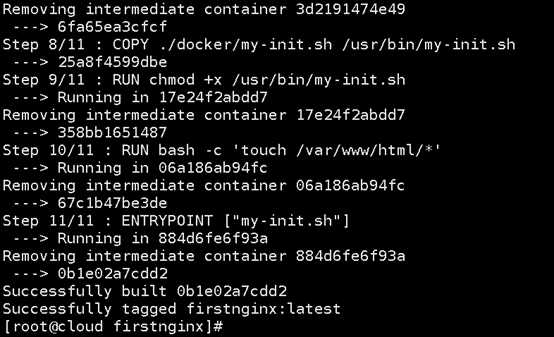环境:CentOS7,Docker CE
1,Use below commands to prepare folders and testing files.
使用如下指令准备文件夹和测试文件
sudo mkdir -p firstnginx/test sudo chmod -Rf 777 firstnginx cd firstnginx echo this is the test1.html > test1.html echo this is the test2.html > test/test2.html

2,Edit Dockerfile
编辑Dockerfile
sudo mkdir -p docker sudo chmod -Rf 777 docker sudo vi docker/Dockerfile
Copy the the content below to the dockerfile:
#拷贝如下内容至Dockerfile
FROM centos:6 MAINTAINER Liping<tlping@163.com> #add nginx repo and install nginx package RUN bash -c "rpm -ivh http://nginx.org/packages/centos/6/noarch/RPMS/nginx-release-centos-6-0.el6.ngx.noarch.rpm && \ yum install -y nginx.x86_64" #copy your customized nginx.conf to the container ADD ./docker/nginx.conf /etc/nginx/nginx.conf #create nginx log folder RUN mkdir -p /etc/nginx/logs #copy full project to nginx web site folder ADD ./ /var/www/html/public/ # publish the container port EXPOSE 80 #copy your shell script to the container COPY ./docker/my-init.sh /usr/bin/my-init.sh #set execution access right RUN chmod +x /usr/bin/my-init.sh #refresh the the container folder files RUN bash -c ‘touch /var/www/html/*‘ #execute the initializaton script ENTRYPOINT ["my-init.sh"]
3,Edit nginx.conf file ,we need change the default website location of nginxserver
sudo vi docker/nginx.conf
Copy below content to the nginx.conf and Save.
#拷贝如下内容至nginx.conf 并且保存

user nginx;
worker_processes 1;
error_log /var/log/nginx/error.log warn;
pid /var/run/nginx.pid;
events {
worker_connections 1024;
}
http {
include /etc/nginx/mime.types;
default_type application/octet-stream;
log_format main ‘$remote_addr - $remote_user [$time_local] "$request" ‘
‘$status $body_bytes_sent "$http_referer" ‘
‘"$http_user_agent" "$http_x_forwarded_for"‘;
access_log /var/log/nginx/access.log main;
sendfile on;
#tcp_nopush on;
keepalive_timeout 65;
#gzip on;
server {
listen 80;
server_name localhost;
#charset koi8-r;
#access_log logs/host.access.log main;
set $root "/var/www/html/public";
root $root;
location / {
root $root;
index index.html index.htm index.php l.php;
try_files $uri /index.php$uri;
}
error_log /var/www/html/err.txt error;
#error_page 404 /404.html;
error_page 500 502 503 504 /50x.html;
location = /50x.html {
root "/var/www/html";
}
location ~ \.php(.*)$ {
root $root;
fastcgi_pass 127.0.0.1:9000;
fastcgi_index index.php;
fastcgi_split_path_info ^((?U).+\.php)(/?.+)$;
fastcgi_param SCRIPT_FILENAME $document_root$fastcgi_script_name;
fastcgi_param PATH_INFO $fastcgi_path_info;
fastcgi_param PATH_TRANSLATED $document_root$fastcgi_path_info;
include fastcgi_params;
}
}
#this statement must be put as the last line
include /etc/nginx/conf.d/*.conf;
}
4,edit my-init.sh file
编辑my-init.sh
sudo vi docker/my-init.sh
copy the content below to the file and save(拷贝如下内容至文件并保存)
#!/bin/sh echo ‘start nginx message now‘ service nginx start echo ‘finish‘ read
after you finish all above ,your current folder structure should be like this,
在你完成所有以上操作后,当前文件夹结构如下,

5,build the dockerfile(编译Dockerfile)
sudo docker build -t firstnginx -f docker/Dockerfile .


6,run the image to start a container(运行Docker镜像以启动容器)
sudo docker run -td --name first_nginx -p 8080:80 firstnginx

7,
sudo docker ps -a | grep first_nginx

8,
Verfiy the test1.html and test/test2.html
Open browser
http://localhost:8080/test1.html
http://localhost:8080/test/test2.html
here use your docker host ip address to replace sys.beserp.com
打开浏览器验证test1.html, test/test2.html文件是否可以被正常访问


The nginx container is working!!
Nginx 运行起来了!
文章版权归属千分网络科技(重庆)有限公司
原文:https://www.cnblogs.com/lipingshare/p/make-a-docker-based-nginx.html